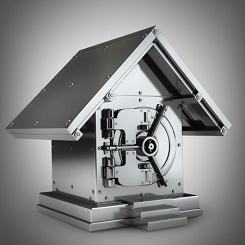
Table of Contents
How to keep the entry points to your home secure
For the second week of National Home Security Month we’re looking at the 2 main entry points into your home – your doors and your windows – and the various ways that you can prevent a burglar from using them to enter your property.
Doors
66% of burglars enter via either the front or back doors. As these are therefore the main points of entry, how do you protect them? These are the things you need to think about in terms of maintaining good door security:
Good quality locks
Your locks are your first defence against an intruder so make sure they’re good ones. At least 25% of break ins are caused by lock snapping where the cylinder is broken to manipulate the lock to open. Anti-snap, or break secure, locks are designed to snap in a pre-determined position so that they remain secure even if tampered with.
The door itself
Obviously a lock is only as good as the door that it’s fitted to. There is no point having a top quality lock in a flimsy door. We advise several things such as a solid door with no glass panel, a spy hole and security chain, no less than 400mm between the lock and the letterbox. Solid uPVC doors with a core of galvanised steel are also recommended. Your door should also be fit into a good quality frame. (See more detailed advice here).
Door contacts linked to burglar alarm
A burglar alarm is an excellent way of securing your home. It will deal with your entry points plus any movement within the home. Contacts on the door will trigger the alarm as soon as someone opens it (if the alarm is set).
Door chimes
Door chimes can be fitted as part of your burglar alarm system or as stand-alone measures to alert you whenever anyone opens or closes the door.
Good door etiquette
Over 30% of break ins are insecure burglaries, ie where a burglar sneaks in through an unlocked door or window. This is such a simple one to avoid – simply make sure your door is locked at all times – even if you’re in the house (30% of burglaries take place while someone is in the house). It’s also a good idea to make sure other entry points are locked when you answer the front door as this can be a distraction method. Door etiquette is all about adopting good habits – keeping doors locked, not leaving keys in the locks or and not keeping them close to the door where they can be hooked out from the outside.
Windows
After doors, windows are the most common point of entry. Here’s what you need to consider:
Keep windows closed
As stated above, around a third of break ins happen via unlocked doors and windows. This is particularly so during summer months when it is warm and it’s nice to have windows open. While it wouldn’t be practical to tell you to never open your windows, especially on a hot day, be vigilant about only having windows open when you’re in the room in question. If you can’t see them, keep them closed.
Lock your windows
Most of us would acknowledge that keeping windows closed is a good idea but how many of us actually lock them? Sometimes windows can be forced open if they’re not secured by a locking system. Especially keep windows locked in rooms you don’t go in much or when you’re away from the home.
Check the quality of ALL windows
Make sure all your windows are solid and secure and not easily broken. Have a good look around – are all your windows good quality? It can just take one weak spot such as a utility room, cellar or garage window that can give a burglar access to your whole house.
First floor windows
Don’t think that just because a window is high, it cannot be penetrated. It may be accessible via an extension roof or by climbing a nearby tree or fence. If you have ladders in your garage, a burglar could potentially use your own equipment against you. Keep your garage and out-buildings locked as well as your home.
Think like a burglar
Probably the best way to avoid a burglar is to think like one. Look around your home as objectively as you can and ‘case’ it for a break in. Where are the weak points? Which access points seem the easiest to get into? Where are you least likely to be seen? Look through the windows, can you see valuable items that would make it worth your while to break in? If you can see anything then you can be damn sure a burglar can. Protecting the entry points, as described above will make any would-be intruder’s job so much harder.
National Home Security Month 2016
This blog has been written as part of NHSM16 and we will continue to post advice all month. Next week we’ll be looking at smart security. See a full run down of plans for the month here.
